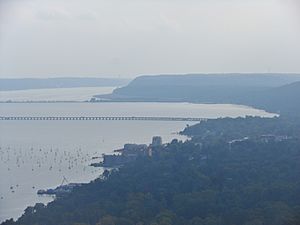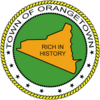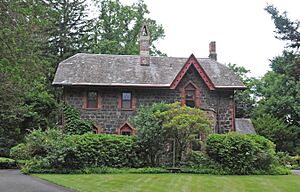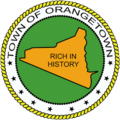Orangetown, New York facts for kids
Quick facts for kids
Orangetown
|
||
|---|---|---|

View of the Hudson River
|
||
|
||

Location in Rockland County and the state of New York.
|
||
| Country | United States | |
| State | New York | |
| County | Rockland | |
| Settled | 1680 | |
| Established | March 7, 1788 | |
| Area | ||
| • Total | 31.33 sq mi (81.15 km2) | |
| • Land | 24.06 sq mi (62.32 km2) | |
| • Water | 7.27 sq mi (18.83 km2) | |
| Elevation | 95 ft (29 m) | |
| Population
(2020)
|
||
| • Total | 48,655 | |
| Time zone | UTC−5 (Eastern (EST)) | |
| • Summer (DST) | UTC−4 (EDT) | |
| FIPS code | 36-55211 | |
| GNIS feature ID | 0979316 | |
| Website | www.orangetown.com | |
Orangetown is a town located in Rockland County, New York, in the United States. It's in the southeastern part of the county. You can find it northwest of New York City and north of New Jersey.
To its east is the Hudson River, and to its west is the town of Ramapo. The town of Clarkstown is to its north. In 2020, about 48,655 people lived in Orangetown.
Contents
A Look Back: The History of Orangetown
Orangetown was first settled around 1680. Dutch settlers bought land from the Tappan Indians in 1686. They called the area "Orange," but it was also known as Orangetown or Tappan.
When New York's first counties were created in 1683, Orangetown was part of Orange County. Later, in 1798, it became part of the new Rockland County.
In the 1800s, the area was known for its beautiful hills and rivers. People quarried red sandstone for building. Farming, especially growing fruit and providing milk for New York City, became important.
Several villages grew over time. Nyack was a busy place with factories and schools. Piermont became a key spot for the New York and Erie Railroad. It had a long pier where goods were moved between trains and boats.
Tappantown was a historic village near the New Jersey border. It was a significant location during the American Revolution. General George Washington even had his headquarters there for a time in 1780.
The Orangetown Resolutions
A very important event happened in Tappan on July 4, 1774. Local leaders passed the Orangetown Resolutions. These were a protest against new taxes and rules from the British Parliament. They were an early step towards the American Revolution.
Exploring Orangetown: Geography
Orangetown covers about 31.4 square miles (81.15 square kilometers). Most of this area, about 24.2 square miles (62.32 square kilometers), is land. The rest is water, mainly from the Hudson River.
The eastern edge of the town is along the Hudson River. The southern border touches New Jersey. To the north, Orangetown borders Clarkstown. To the northwest, it borders Ramapo.
Who Lives Here: Demographics
| Historical population | |||
|---|---|---|---|
| Census | Pop. | %± | |
| 1790 | 1,175 | — | |
| 1820 | 2,257 | — | |
| 1830 | 1,947 | −13.7% | |
| 1840 | 2,771 | 42.3% | |
| 1850 | 4,769 | 72.1% | |
| 1860 | 7,060 | 48.0% | |
| 1870 | 6,810 | −3.5% | |
| 1880 | 8,077 | 18.6% | |
| 1890 | 10,343 | 28.1% | |
| 1900 | 10,456 | 1.1% | |
| 1910 | 14,370 | 37.4% | |
| 1920 | 14,284 | −0.6% | |
| 1930 | 18,029 | 26.2% | |
| 1940 | 26,662 | 47.9% | |
| 1950 | 34,554 | 29.6% | |
| 1960 | 43,172 | 24.9% | |
| 1970 | 53,533 | 24.0% | |
| 1980 | 48,612 | −9.2% | |
| 1990 | 46,742 | −3.8% | |
| 2000 | 47,711 | 2.1% | |
| 2010 | 49,212 | 3.1% | |
| 2020 | 48,655 | −1.1% | |
| U.S. Decennial Census 2020 | |||
In 2020, the population of Orangetown was 48,655 people. The town has grown a lot since it was first settled.
In 2000, there were about 47,711 people living here. About 22.5% of the population was under 18 years old. The average age was 39 years. Most households were families, with many married couples.
Learning in Orangetown: Education
Schools in Orangetown are part of the South Orangetown Central School District. This district helps provide education for students living in the town.
Local Leaders: Elected Representation
Orangetown has a Town Supervisor, who is like the head of the town government. Currently, Teresa Kenny holds this position. The town also has a council-style government with four councilmen. These council members are elected for four-year terms.
Orangetown is part of New York’s 17th Congressional District. This district is represented in the United States House of Representatives by Mike Lawler. In state government, Orangetown is represented by Senator Bill Weber and Assemblyman John McGowan.
Places to See: Communities and Locations
Incorporated Villages
Unincorporated Hamlets
- Blauvelt – A hamlet in the middle of the town.
- Nauraushaun – Located east of Pearl River.
- Orangeburg – A hamlet in the southern part of the town.
- Pearl River – A hamlet in the western part of the town.
- Palisades – Found in the southeastern corner of the town.
- South Nyack – A hamlet just south of the village of Nyack. It used to be an incorporated village until 2022.
- Sparkill – Southwest of the village of Piermont.
- Tappan – Another hamlet in the southeastern corner of the town.
- Upper Grandview – South of the former village of South Nyack.
Other Notable Locations
- Blauvelt State Park – A state park northeast of Blauvelt.
- Dederer Stone House-Stonehurst – A historic building listed on the National Register of Historic Places.
- Lake Tappan – A large reservoir that runs through the town from north to south. It extends into New Jersey.
- Tallman Mountain State Park – A state park in Palisades, south of Piermont.
Getting Around: Transportation
You can catch a commuter train from Pearl River station in Pearl River. This train service, called the Pascack Valley Line by New Jersey Transit, goes south to Hoboken Terminal.
The New York Thruway (which is also I-87) passes through Orangetown. This highway continues east over the Tappan Zee Bridge to Westchester County.
Famous Faces: Notable People
- Bill Murray – A well-known actor.
- George Worth (1915–2006) – An Olympic medalist fencer who was born in Hungary. He also served as the captain of the South Orangetown Ambulance Corps.
Images for kids
See also
 In Spanish: Orangetown para niños
In Spanish: Orangetown para niños










